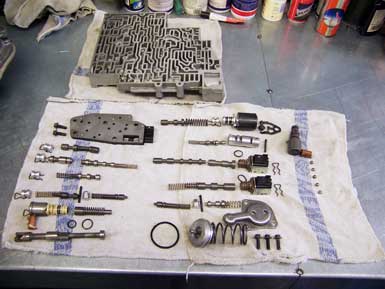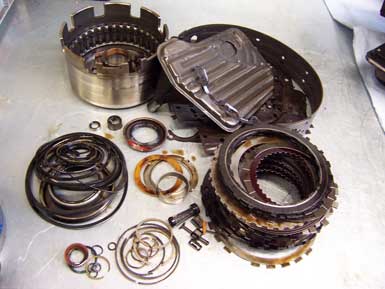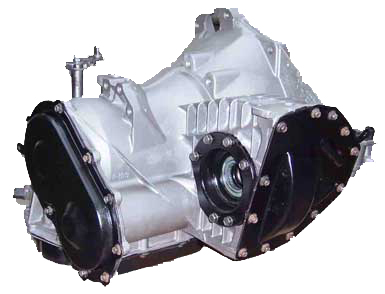Transmissions
Transmissions
 Every automatic transmission will be fully disassembled and all components individually cleaned in our professional grade industrial washers before thoroughly being inspected to ensure rebuildability. Bare cases will be inspected for cast imperfections and warping before being repainted.
Every automatic transmission will be fully disassembled and all components individually cleaned in our professional grade industrial washers before thoroughly being inspected to ensure rebuildability. Bare cases will be inspected for cast imperfections and warping before being repainted.
Hydraulic pumps are checked for wear before new bushings and seals will be installed. Band surfaces on clutch drums will be checked with a straight edge, sprag assemblies, planetary assemblies and all other “hard parts” will be carefully checked for wear before admitted to the remanufacturing process. Critical hard parts are being replaced with new regardless of wear grade.
Now the actual remanufacturing process starts:
Hydraulic servo seals will be replaced before installed in clutch housings with new frictions and steals.
 It is very important to maintain the OEM required clutch clearances, adjustments can be made by using steal plates of different sizes. Too much clearance will result in a delayed shift process with brief moments of slipping causing premature clutch failure.Insufficient clearance will also cause premature failure due to friction. Subsequently each clutch will be bench tested with compressed air simulating hydraulic oil pressure.
It is very important to maintain the OEM required clutch clearances, adjustments can be made by using steal plates of different sizes. Too much clearance will result in a delayed shift process with brief moments of slipping causing premature clutch failure.Insufficient clearance will also cause premature failure due to friction. Subsequently each clutch will be bench tested with compressed air simulating hydraulic oil pressure.
Replacing all servo seals is extremly important, installing new frictions and steel plates only will not be sufficient. The rubber lip seals become hard and porous due to age and heat sealing the hydraulic system only insufficient. The servos cannot apply enough pressure onto the clutches while engaging causing clutch slipping and immediate failure.
Before final assembly any worn bushings,needle bearings and washers will be replaced along with all sealing rings to ensure proper sealing of all hydraulic and lubrication passages.
All paper gaskets, rubber-and metal clad seals will be replaced during final assembly.
Another important and highly complex component gone through during the remanufacturing process is the valve body, literally the brain of the transmission. Dozens of small valves working against spring pressure inside a cast iron or aluminum housing cause the transmission to engage or disengage clutches and bands depending on individual driving conditions and throttle positions. The valve body also controls hydraulic line pressure on most transmissions. Wharped valve body housings due to overtorqued valve body bolts or improper torque sequence or tiniest dirt particles can cause sticky valves or abrasive inside the valve passages resulting in abnormal shifting, slipping clutches and bands.
Great care will be necessary when working on a valve body: after complete disassembly all valves, springs, check balls and the housing will be cleaned in an ultra-sonic cabinet. The gasket surface of the housing will be checked with a straight edge, worn passages will be sleeved and valves polished if necessary. Prior to installation of the valve body with new gaskets, check balls and spacer plate all internal clutches and band servos will once again be tested: a transmission type specific testing plate will be bolted to the valve body flange on the bottom of the transmission case providing feed holes into the case passages to test internal hydraulic components with air rather than hydraulic oil pressure. Any possible hydraulic malfunction would be caught with this test procedure. Once the valve body will be reinstalled with proper torque specifications and sequence the bands will be adjusted according to OEM specifications (if applicable). On electronic-controlled transmissions we will also test solenoids (if possible), crucial electronic components like for example the governor pressure sensor on Chrysler transmissions will always be replaced regardless.

Finally a new oil filter and pan will be installed before finishing the transmission with a remanufactured torque converter on most applications.
Due to their complexity and difficult operation automatic transmissions should only be serviced by competent professionals with years of experience. It is also necessary to have a broad variety of special tool and access to type specific information, service bulletins and updates/changes that have been applied by the OE manufacturer during the different model years.